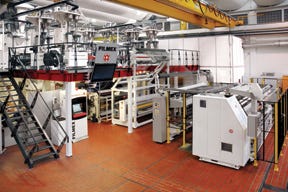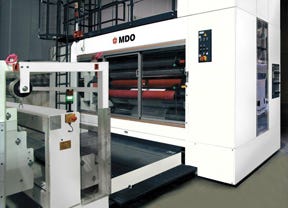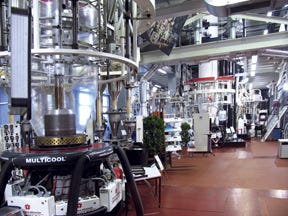Bevy of film developments
unleashed at in-house fair
First in line to show what visitors to this year’s K 2010 show can expect is film-processing equipment maker Windmöller & Hölscher (W&H; Lengerich, Germany).The company premiered a number of film-production technology developments at its open house in late autumn. Christof Herschbach, division manager engineering–extrusion equipment, told MPW at the event that top on the list of debuts is the company’s Optimex three-layer blown film line.
January 5, 2010
First in line to show what visitors to this year’s K 2010 show can expect is film-processing equipment maker Windmöller & Hölscher (W&H; Lengerich, Germany).
The company premiered a number of film-production technology developments at its open house in late autumn. Christof Herschbach, division manager engineering–extrusion equipment, told MPW at the event that top on the list of debuts is the company’s Optimex three-layer blown film line.
|
Despite extrusion trends towards five-, seven-, and nine-layer lines, processors still have a need for lines that produce standard, commodity web for such things as auto packaging applications, carrier bags, laminating films, as well as shrink and stretch wrap, says Herschbach. The new unit is designed to “keep it simple” and is intended for the processor who may not need or even want all the bells and whistles on the company’s modular, but more costly, Varex three-layer line. The Optimex is more off-the-shelf than Varex and offers just two three-layer die options in 160- to 315-mm (6- to 12-inch) or 250- to 400-mm (10- to 16-inch) configurations. Extruder combinations are either 60/70/60.30 L/D or 60/90/60.30 L/D to produce film widths of 1300, 1600, or 1800 mm (51, 63, or 71 inches) or hood production of 2200 or 2600 mm (87 or 102 inches).
W&H sees the “Made in Germany” label on this unit as a big seller to processors who might typically opt for less expensive yet also lower-quality competitive units. Herschbach admits there is, of course, the danger that processors who might ordinarily opt for a three-layer Varex line will instead choose the cheaper Optimex, but he sees a market for both product lines. Unlike the company’s Basic blown-film line introduced back in 1995, which represented a stripped-down machine for a lower price, the Optimex, says Herschbach, is based on a standardized line of high-quality components said to guarantee cost-effective manufacturing.
Also new from the company is an inverted, water-cooled blown-film extrusion line, Aquarex, designed to nibble away at the cast-film market. It likely won’t compete with cast lines on output, but W&H says it promises an amorphous end product with similar or better gloss, haze levels, and mechanical properties (such as dart-drop, puncture, and tear strength). Tempered, demineralized water quenches the bubble faster than traditional air-cooled lines. This permits line height to be reduced, a factor expected to appeal to processors with low plant ceilings. The unit’s haul-off is stainless steel to protect against water corrosion.
Equipped with a Varex module package of extruders, Maxicone die head, and Filmatic T winder, the line can handle three- to nine-layer processing. During the open house W&H was churning out three-layer polypropylene (PP) infusion bag film (20-µm soft PP/13-µm stiffer PP/50-µm soft PP), designed to substitute for similar applications in PVC. All PP materials were from Danish compounder Melitek (Nr. Alslev).
The Aquarex’s output is suitable for subsequent upgrading on an MDO (machine direction orientation) stretching unit. W&H unveiled an MDO unit similar to one it first mentioned at K 2007. The new MDO line is said to improve web tensile strength and rigidity while providing better shrink performance. Bumping up gloss and clarity are additional advantages. It features 12 temperature-controlled rollers, 12 lay-on rollers, and two stretching nips. Stretch ratio is to a maximum of 1:12.
Herschbach says film stretching offers the potential for processors to use less expensive resins to get a high-quality end product while reducing the use of expensive barrier materials such as nylon or ethylene vinyl alcohol (EVOH). Lab tests at W&H show that by offline stretching a 40-µm barrier film, a processor can expect a 30% barrier improvement compared to the same film if it is not stretched.
Other innovations shown during the open house included an improved Opticool air ring system said to provide high cooling capacity thanks to its double-deck air ring. In winding, W&H was showing its Filmatic N winder used in conjunction with a three-layer Varex blown-film line. It can handle films up to 3600 mm (102 inches). A vacuum cutter drum (VSK) enables roll start with no foldback as well as automatic shaft handling. On the cast film side, the company was producing a 17-layer stretch film on its Filmex cast line using eight extruders and a Cloeren (Orange, TX) 2700-mm die with encapsulation and a nano-layer feedblock. Nano layers permit combining stiff and soft resins to get improved puncture resistance, better stretch, and downgauging. —Robert Colvin
About the Author(s)
You May Also Like





